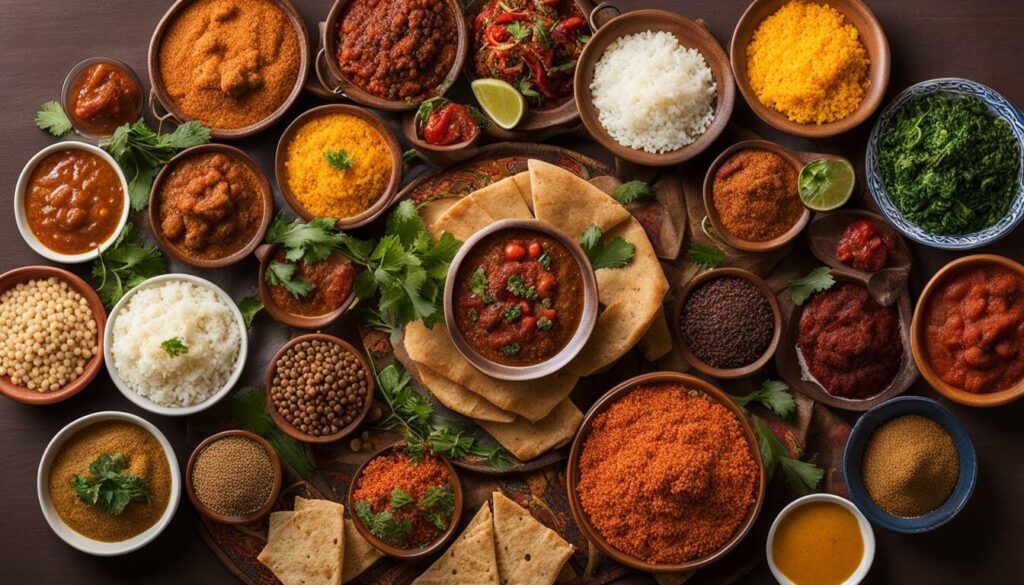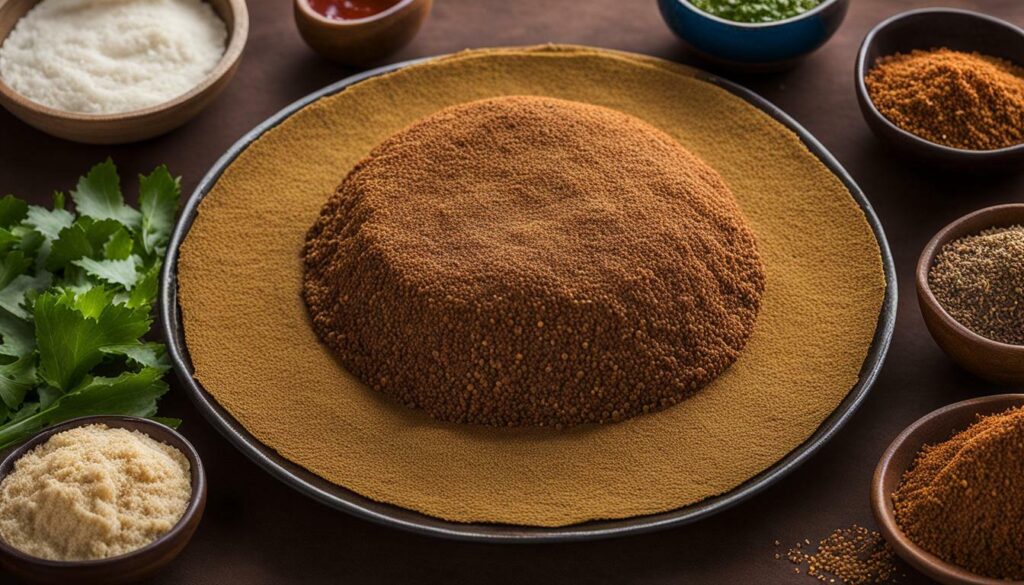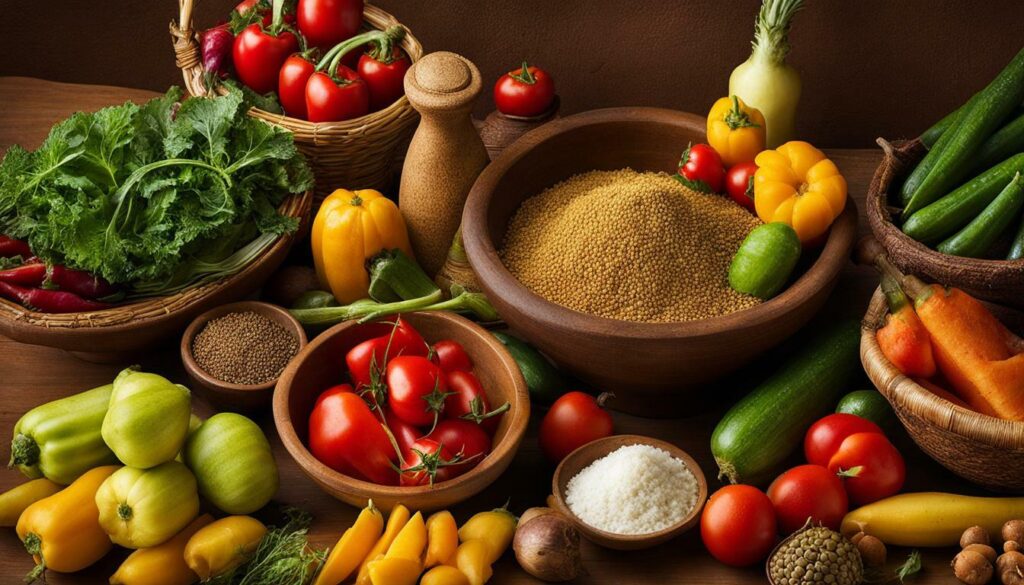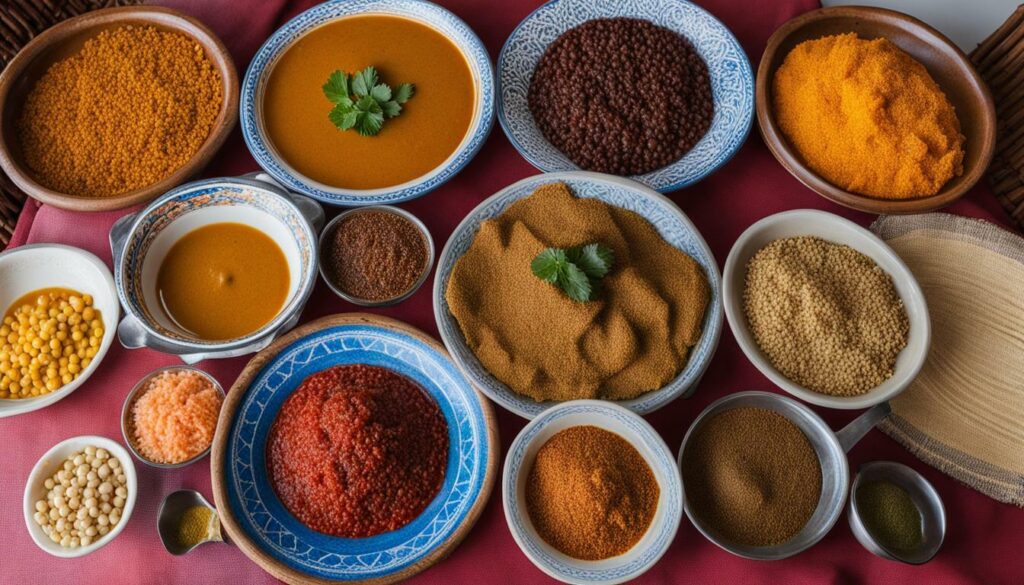Eritrea, a country located in the Horn of Africa, has a rich history of traditional foods that have shaped its past and continue to influence its present diet.
Key Takeaways
- Eritrea has a diverse culinary heritage, with traditional foods playing a significant role in the country’s culture.
- Injera, a flatbread made from teff grain, is the staple food of Eritrea.
- Eritrean cuisine shows influences from its history as an Italian colony, with the use of tomatoes being more prominent compared to Ethiopian cuisine.
- Dietary preferences within the Eritrean diaspora vary depending on cultural contexts and adaptations to new environments.
- Psychosocial factors and environmental influences play a crucial role in shaping the diets of Eritrean communities, both in Eritrea and abroad.
Traditional Eritrean Foods: A Culinary Heritage
Traditional Eritrean foods form the cornerstone of the country’s culinary heritage, reflecting its diverse cultural influences and unique flavours. The cuisine of Eritrea is a rich fusion of indigenous traditions with influences from neighbouring Ethiopia, Yemen, Italy, and other countries. These cultural influences have shaped Eritrean cuisine into a vibrant and flavoursome culinary tradition.
In Eritrea, traditional foods play a significant role in daily life and special occasions, celebrating the country’s cultural diversity. The cuisine is known for its use of fresh and locally sourced ingredients, including a variety of grains, legumes, vegetables, and spices. The iconic dish of Eritrean cuisine is injera, a sourdough flatbread made from teff grain. Injera is served with a variety of stews and sauces, creating a communal and interactive dining experience.
Eritrean cuisine also showcases the influence of Italy, as Eritrea was a former Italian colony. This influence can be seen in the extensive use of tomatoes in Eritrean dishes, adding a delightful tanginess to the flavours. The fusion of Italian and Eritrean flavours can be found in popular dishes such as zigni, a spicy stew, and pasta dishes infused with Eritrean spices.
Overall, Eritrean cuisine offers a captivating culinary experience, intertwining tradition, culture, and history into each flavorful dish. Whether you’re enjoying injera with spicy stews or savouring the unique flavours of Italian-Eritrean fusion, the cuisine of Eritrea promises a delightful journey for the senses.

Table: Traditional Eritrean Dishes
| Dish | Description |
|---|---|
| Shiro | A thick stew made from ground chickpeas, lentils, or split peas, seasoned with spices and served with injera. |
| Tsebhi Birsen | A flavorful meat stew made with beef, lamb, or chicken, simmered with onions, garlic, and aromatic spices. |
| Tibsi | Grilled meat, typically beef or lamb, marinated with spices, served with sautéed onions and peppers. |
| Berenjena | A dish made from roasted eggplant, blended with tomatoes, garlic, and spices, resulting in a savoury dip. |
“Eritrean cuisine offers a captivating culinary experience, intertwining tradition, culture, and history into each flavorful dish.”
Injera: The Staple Food of Eritrea
Injera holds a special place in Eritrean cuisine, serving as the foundation of many meals and representing the country’s culinary identity. This traditional flatbread is made from teff grain, a staple crop in Eritrea. With its unique spongy texture and slightly sour taste, injera is not only a versatile accompaniment to various dishes but is also used as a utensil in Eritrean meals.
Eritrean cuisine is known for its diverse flavours and use of simple, wholesome ingredients. Injera is often served with a variety of stews, lentils, and vegetables, creating a balanced and nutritious meal. The injera itself is made through a process of fermentation, where the teff grain is ground, mixed with water, and left to ferment for a few days. The resulting batter is then cooked on a large, round griddle called a mitad.

The cultural significance of injera goes beyond its role as a staple food. In Eritrean meal traditions, sharing a meal with family and friends is an important social activity, and injera plays a central role in this communal experience. It is customary to tear off a piece of injera and use it to scoop up the various dishes on the table, fostering a sense of unity and togetherness.
The popularity of injera has spread beyond Eritrea, with Eritrean restaurants and communities around the world introducing this beloved staple to international audiences. Its unique flavour and cultural significance have made it a favourite among those seeking to explore the diverse cuisines of Africa. Whether enjoyed at home or in a restaurant, injera continues to be a cherished symbol of Eritrean culinary heritage.
Influences from Eritrea’s History as an Italian Colony
Eritrea’s history as an Italian colony has left a lasting impact on its culinary traditions, with Italian influences evident in the incorporation of tomatoes and the fusion of flavours in certain dishes. Italian cuisine played a significant role in shaping and enriching Eritrean gastronomy, creating a unique fusion of African and Mediterranean flavours.
The use of tomatoes, introduced by the Italians, is particularly notable in Eritrean dishes. The vibrant red fruit adds a burst of flavour and colour to many traditional recipes. Tomatoes are featured prominently in dishes such as Zigni, a spicy meat stew, and Tsebhi Sga, a flavorful spinach stew. These dishes showcase the blending of Italian and Eritrean culinary influences, creating a harmonious fusion of flavours that is distinctively Eritrean.
One of the most popular Eritrean dishes that showcases the Italian influence is Pasta al Sugo, a pasta dish with a rich tomato sauce. This fusion of Italian and Eritrean flavours has become a beloved comfort food in Eritrean cuisine. The dish combines traditional Italian pasta with the bold flavours of Eritrean spices, creating a delightful and satisfying meal that reflects the cultural diversity of the country’s history.
The Italian influence on Eritrean cuisine is a testament to the country’s rich and diverse culinary heritage. It highlights the adaptability and ingenuity of Eritrean chefs in incorporating foreign influences while maintaining the authenticity of their traditional foods. The blending of Italian and Eritrean flavours has resulted in delicious and unique dishes that are cherished by locals and appreciated by food enthusiasts around the world.

Eritrean Recipes
| Dish | Origin | Main Ingredients |
|---|---|---|
| Injera | Eritrea | Teff flour, water, salt |
| Zigni | Eritrea | Beef, tomatoes, onions, garlic, berbere spice blend |
| Tsebhi Sga | Eritrea | Spinach, tomatoes, onions, garlic, chilli peppers |
| Pasta al Sugo | Italian-Eritrean fusion | Pasta, tomato sauce, onions, garlic, Eritrean spices |
“The blending of Italian and Eritrean flavors has resulted in delicious and unique dishes that are cherished by locals and appreciated by food enthusiasts around the world.”
Eritrean Cuisine Around the World
While Eritrean cuisine may not be widely available in many countries, its unique flavours and cultural significance are gaining recognition among adventurous food enthusiasts. Eritrean traditional foods offer a delightful mix of aromatic spices, vibrant colours, and diverse ingredients, making it a true culinary gem worth exploring.
Eritrean cuisine showcases a range of traditional foods that reflect the country’s rich cultural heritage. The staple food in Eritrea is injera, a spongy flat bread made from teff grain. With its slightly sour taste and soft texture, injera serves as a versatile accompaniment to various meat, vegetable, and lentil dishes. Its importance in Eritrean meals cannot be overstated, as it serves as a vessel for scooping up flavorful stews and curries.
Eritrean food also bears influences from the country’s history as an Italian colony. This is evident in the use of tomatoes in Eritrean dishes, which adds a unique twist to the flavours. The fusion of Italian and Eritrean flavours can be seen in certain recipes, creating a harmonious blend of tastes that is both familiar and exciting.
As Eritrean communities thrive around the world, Eritrean cuisine is finding its way into international markets and gaining popularity beyond its borders. The growing interest in Eritrean traditional foods is a testament to the richness and diversity of Eritrean culinary traditions. Adventurous food enthusiasts are discovering the flavours of Eritrea and embracing its vibrant cuisine with open arms.

Embark on a culinary journey and experience the wonders of Eritrean cuisine through its traditional foods. The fusion of flavours, the use of aromatic spices, and the cultural significance attached to the dishes make Eritrean cuisine a true delight for the senses. Whether you find yourself in an Eritrean restaurant or decide to try your hand at cooking traditional Eritrean recipes at home, you’re sure to be captivated by the rich flavours and culinary heritage of this remarkable country.
Discover the joy of injera, savour the tantalizing flavours of Eritrean stews and curries, and explore the diverse ingredients that make up this vibrant cuisine. Eritrean cuisine is a true reflection of the country’s history, culture, and identity, and it is a culinary experience that should not be missed.
| Key Points | Summary |
|---|---|
| Eritrean cuisine | Gaining recognition among adventurous food enthusiasts |
| Injera | Staple food made from teff grain |
| Italian influences | Use of tomatoes and fusion of flavors |
| Popularity outside Eritrea | Growing interest in Eritrean traditional foods worldwide |
Festive and Celebratory Foods in Eritrea
Eritrea’s festive and celebratory foods play a central role in cultural traditions, adding a sense of joy and togetherness during special occasions. These culinary delights are a reflection of the rich heritage and diverse ethnic groups that make up the country’s population. From weddings and religious festivities to national holidays, Eritreans gather to share and savour traditional dishes that have been passed down through generations.
One popular and widely enjoyed dish during festive occasions is Zigni, a spiced meat stew made with beef or lamb. It is often served with injera, the staple flatbread of Eritrea, which is used to scoop up the flavorful stew. The combination of tender meat and aromatic spices creates a truly mouthwatering experience.
Another beloved festive dish is Berenjena, a delicious eggplant dish that is often prepared for special celebrations. This savoury dish features cooked eggplant mixed with tomatoes, onions, garlic, and a variety of herbs and spices. The flavours meld together to create a harmonious blend of tastes and textures.
| Traditional Festive Foods in Eritrea | Description |
|---|---|
| Zigni | A spiced meat stew made with beef or lamb, often served with injera. |
| Berenjena | A savoury eggplant dish prepared with tomatoes, onions, garlic, and herbs. |
| Molokhia | A hearty stew made from jute leaves and various meats, often served with bread. |
Molokhia is another dish that holds a special place in Eritrean festive celebrations. This hearty stew is made from jute leaves and can be prepared with different types of meats, such as chicken, beef, or lamb. It is often served with bread, allowing diners to soak up the flavoursome sauce.
These festive and celebratory foods not only satisfy the taste buds but also serve as a reminder of Eritrea’s culinary heritage and cultural identity. They bring families and communities together, strengthening bonds and creating cherished memories. Whether enjoyed during weddings, religious holidays, or national festivities, these dishes showcase the vibrant and diverse food culture of Eritrea.

The Evolving Food Habits in Eritrea
Like many nations in the modern world, Eritrea is experiencing a shift in food habits due to various factors such as globalization and changing lifestyles. Traditional Eritrean foods still hold a special place in the hearts of Eritreans, but there is also an increasing influence of international cuisines and a growing interest in fusion dishes.
Eritrean cuisine, with its rich flavours and diverse ingredients, has a unique culinary heritage. Traditional Eritrean foods like injera, a sourdough flatbread made from teff grain, continue to be a staple in Eritrean households. It is served with a variety of stews and sauces, creating a communal dining experience where everyone shares from a common platter.
However, as Eritrea becomes more connected to the global food scene, there has been an emergence of new food trends and flavours. Eritrean restaurants outside of Eritrea offer a fusion of traditional Eritrean dishes with influences from other cuisines, catering to the evolving tastes of the population.
While the younger generation in Eritrea is embracing these culinary changes, there is also a strong emphasis on preserving traditional food practices and ingredients. Many Eritreans recognize the importance of staying connected to their cultural roots through food, and efforts are being made to promote and sustain traditional Eritrean foods.
As Eritrean food continues to evolve, it is important to strike a balance between embracing the diversity that globalization brings and preserving the unique flavors and culinary traditions that have been passed down through generations.
Overall, the evolving food habits in Eritrea reflect the changing times and the influences of a globalized world. Traditional Eritrean foods remain an integral part of Eritrean culture, while also embracing new flavors and culinary experiences. Whether it’s indulging in the comforting flavours of injera or exploring the fusion of Eritrean and international cuisines, the food scene in Eritrea is a reflection of its vibrant and diverse heritage.

The Dietary Diversity of the Eritrean Diaspora
The Eritrean diaspora exemplifies the rich dietary diversity that stems from the country’s traditional foods, with Eritrean communities around the world finding ways to maintain their culinary heritage. Despite being scattered across different continents, Eritreans have managed to preserve the flavours and techniques of their traditional cuisine, adapting their diets to local ingredients and cultural contexts.
One of the key factors contributing to this dietary diversity is the resourcefulness of Eritrean communities in sourcing ingredients and recreating traditional dishes. Even in countries where Eritrean ingredients may not be readily available, Eritreans have found substitutes and creative solutions to retain the unique flavours of their traditional foods. This adaptability has allowed them to maintain their cultural identity and pass down their culinary traditions to future generations.

| Eritrean Recipes | Available Ingredients |
|---|---|
| Tsebhi (meat stew) | Chicken, beef, lamb |
| Berenjena (eggplant dish) | Eggplant, tomatoes, onions |
| Zigni (spicy beef stew) | Beef, berbere spice mix |
This diversity within the Eritrean diaspora is also influenced by the cultural contexts in which Eritreans find themselves. For example, Eritrean communities in the United States have been influenced by the African-born and Caribbean/Latin American-born Black populations. This cultural exchange has resulted in the fusion of Eritrean and other African culinary traditions, further enriching the variety of Eritrean dishes.
This global spread of Eritrean cuisine has also led to an increased interest in Eritrean traditional foods worldwide. As more people discover the unique flavours and cultural significance of Eritrean dishes, there is a growing demand for Eritrean restaurants and recipes. This not only promotes the culinary heritage of Eritrea but also fosters cultural exchange and appreciation among different communities.
Dietary Preferences and Cultural Identity in the UK Black Population
The UK Black population exhibits a fascinating blend of dietary preferences, influenced by cultural identity and the diverse origins of its members. This is particularly evident in the culinary choices of individuals from Eritrea, a country with a rich food heritage. Traditional Eritrean foods are cherished by the Eritrean diaspora in the UK, serving as a connection to their cultural roots and a way to maintain their identity.

Eritrean cuisine encompasses a variety of dishes, characterized by an array of flavours and spices. Traditional foods in Eritrea often consist of injera, a sourdough flatbread made from teff grain, which is central to Eritrean meals. This gluten-free bread is used to scoop up various stews, lentil dishes, and vegetables, creating a uniquely communal dining experience.
Caribbean and Latin American-born Blacks in the UK have also been influenced by Eritrean cuisine. The similarities in ingredients and cooking techniques between Eritrean and Caribbean/Latin American cuisines have led to culinary fusion and adaptation. For example, Eritrean spices and flavours find their way into Caribbean dishes, adding a delightful twist to traditional recipes.
Despite its popularity among the Eritrean diaspora, Eritrean cuisine remains relatively unknown to the wider UK population. However, there has been a growing interest in exploring diverse culinary traditions, and Eritrean restaurants are gradually gaining recognition for their authentic dishes. This newfound appreciation for Eritrean cuisine not only provides an opportunity for cultural exchange but also contributes to the preservation and celebration of Eritrean culinary heritage in the UK.
| Eritrean Foods | Description |
|---|---|
| Injera | A sourdough flatbread made from teff grain |
| Wat | A spicy stew typically made with herbs, meat, and vegetables |
| Zigni | A savoury beef stew flavoured with a variety of spices |
| Tsebhi | A rich and flavorful stew made with chicken, lamb, or beef |
The Impact of Psychosocial Factors and Environmental Influences on Eritrean Diets
The food choices in Eritrea are influenced by a combination of psychosocial factors and environmental influences, which shape the dietary patterns and preferences of its population. These factors play a crucial role in determining the availability and affordability of certain foods, as well as the cultural and social norms surrounding food consumption.
Psychosocial factors, such as cultural beliefs, traditions, and personal experiences, have a significant impact on Eritrean diets. Traditional Eritrean foods hold a strong cultural significance and are often associated with identity and heritage. Eritreans may prioritize maintaining their culinary traditions, passing them down through generations, and considering them an essential part of their cultural identity.

Environmental influences also play a crucial role in shaping Eritrean diets. The availability of fresh, locally sourced ingredients and the accessibility of markets and food distribution networks greatly impact the food choices of the Eritrean population. Factors such as climate, agricultural practices, and geographical location contribute to the variety of foods available and influence the selection of ingredients in traditional Eritrean recipes.
| Psychosocial Factors | Environmental Influences |
|---|---|
|
|
“Food is not just sustenance in Eritrea; it is a reflection of our heritage and cultural identity. Our food choices are deeply rooted in our traditional values, and we take pride in preserving our culinary traditions for future generations.” – Eritrean Food Enthusiast
Understanding the impact of psychosocial factors and environmental influences on Eritrean diets is crucial for promoting sustainable and culturally sensitive approaches to nutrition. By considering these factors, policymakers, healthcare professionals, and nutritionists can better support the diverse dietary needs and preferences of the Eritrean population, while also ensuring the preservation of Eritrean food traditions.
Conclusion
The exploration of past and present diets in Eritrea offers valuable insights into the cultural heritage and evolving food habits of this diverse nation. Understanding the traditional foods and culinary practices of Eritrea allows us to appreciate the rich tapestry of flavours and techniques that have shaped the country’s cuisine over time.
One of the defining features of Eritrean cuisine is the staple food known as injera. This flatbread made from teff grain holds great cultural significance and is a common element in Eritrean meals. With its sourdough tang and spongy texture, injera serves as a versatile base for various stews and dishes, showcasing the skill and creativity of Eritrean cooks.
Eritrea’s history as an Italian colony has also left its mark on the country’s food culture. The influence of Italian flavours can be seen in the use of tomatoes in Eritrean dishes, adding a vibrant and distinct element to the traditional cuisine. This fusion of Italian and Eritrean flavours creates a unique culinary experience that is both familiar and unfamiliar.
As Eritrean communities have spread across the globe, the availability and popularity of Eritrean cuisine have grown. However, promoting and preserving traditional foods outside of Eritrea brings its own set of challenges. Yet, the increasing interest in Eritrean cuisine worldwide highlights the global appreciation for the country’s culinary contributions.
In conclusion, exploring the past and present diets of Eritrea allows us to appreciate the cultural heritage and evolving food habits of this diverse nation. From the traditional injera to the fusion of Italian and Eritrean flavours, Eritrean cuisine offers a unique culinary experience that continues to captivate the taste buds of people around the world. Preserving and celebrating Eritrean food traditions not only pays homage to the country’s rich culinary heritage but also fosters a sense of cultural pride and identity within Eritrean communities worldwide.
FAQ
What are the traditional foods of Eritrea?
Traditional foods in Eritrea include injera, a flatbread made from teff grain, and various stews and curries.
How widely available is Eritrean and Ethiopian food in the UK?
Eritrean and Ethiopian food is not widely available in the UK, with only a few restaurants serving these cuisines.
Is there a difference between Eritrean and Ethiopian cuisine?
Eritrean cuisine uses more tomatoes compared to Ethiopian cuisine, which may be influenced by Eritrea’s history as an Italian colony.
How diverse is the diet of the Black population in the US?
The diet of the Black population in the US is diverse, encompassing African-born and Caribbean/Latin American-born Blacks with distinct cultural dietary preferences.
What factors shape the diet of the US Black population?
Psychosocial factors and environmental influences are significant in shaping the diet of the ethnically diverse US Black population, including cultural identity and adaptive strategies.
Are there Eritrean restaurants outside of Eritrea?
Eritrean cuisine is gaining popularity worldwide, with an increasing number of Eritrean restaurants catering to the global demand.
Source Links
- https://www.theguardian.com/lifeandstyle/2009/jun/17/hannah-pool-eritrean-food
- https://globalnutritionreport.org/resources/nutrition-profiles/africa/eastern-africa/eritrea/
- https://www.ncbi.nlm.nih.gov/pmc/articles/PMC6635804/



